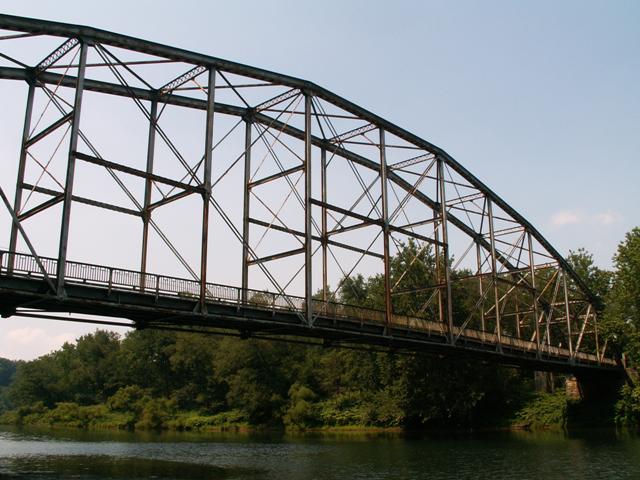We Recommend:
Bach Steel - Experts at historic truss bridge restoration.
Tunnelton Bridge

Primary Photographer(s): Nathan Holth and Rick McOmber
Bridge Documented: August 1, 2007
Rural: Indiana County, Pennsylvania and Westmoreland County, Pennsylvania: United States
1938 By Builder/Contractor: American Bridge Company of New York, New York
Not Available or Not Applicable
396.0 Feet (120.7 Meters)
402.0 Feet (122.5 Meters)
21.7 Feet (6.61 Meters)
1 Main Span(s)
323003001000000

View Information About HSR Ratings
Bridge Documentation
This bridge no longer exists!
View Archived National Bridge Inventory Report - Has Additional Details and Evaluation
This historic bridge was demolished by PennDOT on October 20, 2010!
This bridge has a long span that soars over the river via a magnificent single 402 foot span, when most other historic bridges in the area crossing this river do so in a multi-span format. Indeed, this bridge is one of the more unusual bridges to be featured on this website. The bridge features a combination of riveted and pinned connections. Pinned connections were not usually used in the 1930s, and had been largely replaced by riveted connections for nearly 30 years by that time. The bridge features a combination of rolled and built-up beams composing the truss structure. The top chord and end post is a built-up box beam and the underside of the box beam is assembled with plate steel that features holes cut into it... this is a design that would become quite common by the 1950s on truss bridges, but the appearance of this design on a 1930s bridge makes the Tunnelton Bridge an early example of this design. The bridge also features an unusual design of railing, which appears to be original to the structure. Finally, the bridge is significant simply as an example of an uncommon truss configuration, the Pennsylvania truss. The bridge should also be considered significant for its span length.
Information and Findings From Pennsylvania's Historic Bridge InventoryDiscussion of Bridge The one span, 402' Pennsylvania thru truss bridge is supported on ashlar abutments with flared wingwalls from an earlier bridge. The trusses are traditionally composed. The upper chords and inclined end posts are built up box sections, and the verticals are rolled I section. Bracing members are built up. The upper panel point connections are riveted, but the intermediate connections and the lower panel point connections throughout are pinned with the exception of the end panels of the lower chords, which are riveted. The bridge is long, but it has no innovative details. It utilizes technology that was well established in 1910, and is not uncommon in the region. The bridge is not historically or technologically significant. Discussion of Surrounding Area The bridge carries a 2 lane road over a stream in a sparsely developed, rural area with scattered 20th century residences near Tunnelton at the Indiana-Westmoreland county line. Buildings adjacent to the bridge include a junk yard, a cinder block building, and altered early 20th century houses. The setting does not have historic district potential. Bridge Considered Historic By Survey: Not Initially, Later Found Eligible in 2001 |
![]()
Photo Galleries and Videos: Tunnelton Bridge
Bridge Photo-Documentation
A collection of overview and detail photos. This photo gallery contains a combination of Original Size photos and Mobile Optimized photos in a touch-friendly popup viewer.Alternatively, Browse Without Using Viewer
![]()
Maps and Links: Tunnelton Bridge
This historic bridge has been demolished. This map is shown for reference purposes only.
Coordinates (Latitude, Longitude):
Search For Additional Bridge Listings:
Bridgehunter.com: View listed bridges within 0.5 miles (0.8 kilometers) of this bridge.
Bridgehunter.com: View listed bridges within 10 miles (16 kilometers) of this bridge.
Additional Maps:
Google Streetview (If Available)
GeoHack (Additional Links and Coordinates)
Apple Maps (Via DuckDuckGo Search)
Apple Maps (Apple devices only)
Android: Open Location In Your Map or GPS App
Flickr Gallery (Find Nearby Photos)
Wikimedia Commons (Find Nearby Photos)
Directions Via Sygic For Android
Directions Via Sygic For iOS and Android Dolphin Browser
USGS National Map (United States Only)
Historical USGS Topo Maps (United States Only)
Historic Aerials (United States Only)
CalTopo Maps (United States Only)


